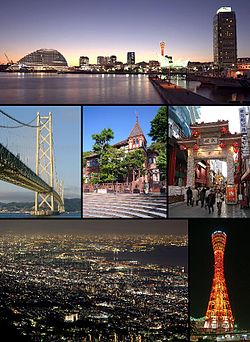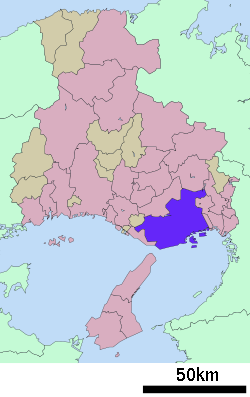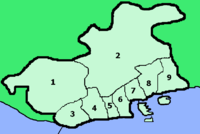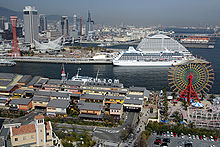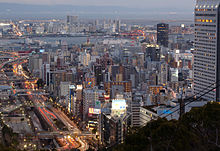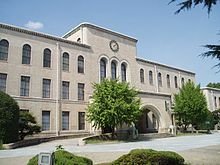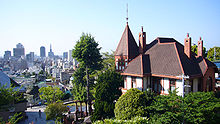- Kobe
-
Kobe
神戸— Designated city — 神戸市 · Kobe City[1] From top left: Port of Kobe, Akashi Kaikyō Bridge, Kitano-chō, Kobe Chinatown, Night View from Kikuseidai of Mt. Maya, Kobe Port Tower 
Flag
LogoLocation of Kobe in Hyōgo Coordinates: 34°41′24″N 135°11′44″E / 34.69°N 135.19556°ECoordinates: 34°41′24″N 135°11′44″E / 34.69°N 135.19556°E Country Japan Region Kansai Prefecture Hyōgo Government – Mayor Tatsuo Yada Area – Total 552.26 km2 (213.2 sq mi) Population (August 1, 2011) – Total 1,545,410 – Density 2,798.3/km2 (7,247.7/sq mi) Time zone Japan Standard Time (UTC+9) City Symbols - Tree Camellia sasanqua - Flower Hydrangea Phone number 078-331-8181 Address 6-5-1 Kano-chō, Chūō-ku, Kōbe-shi, Hyōgo-ken
650-8570Website City of Kobe Kobe (神戸市 Kōbe-shi), pronounced koːbe, is the fifth-largest city in Japan and is the capital city of Hyōgo Prefecture on the southern side of the main island of Honshū, approximately 30 km (19 mi) west of Osaka. With a population of about 1.5 million, the city is part of the Keihanshin (Keihanshin) metropolitan area along with Osaka and Kyoto.
The earliest written records regarding the region come from the Nihon Shoki, which describes the founding of the Ikuta Shrine by Empress Jingū in AD 201.[2][3] For most of its history the area was never a single political entity, even during the Tokugawa Period, when the port was controlled directly by the Tokugawa Shogunate. Kobe did not exist in its current form until its founding in 1889. Its name comes from "kanbe" (神戸), an archaic title for supporters of the city's Ikuta Shrine.[4][5] Kobe became one of Japan's 17 designated cities in 1956.
Kobe was one of the cities to open for trade with the West following the end of the policy of seclusion and has since been known as a cosmopolitan port city. While the 1995 Great Hanshin Earthquake diminished much of Kobe's prominence as a port city, it remains Japan's fourth busiest container port.[6] Companies headquartered in Kobe include ASICS, Kawasaki Heavy Industries, and Kobe Steel, as well as over 100 international corporations with Asia or Japan headquarters in the city such as Procter & Gamble, Boehringer-Ingelheim and Nestlé.[7][8] The city is the point of origin and namesake of Kobe beef as well as the site of one of Japan's most famous hot spring resorts, Arima Onsen.
Contents
History
 Media related to History of Kobe at Wikimedia Commons
Media related to History of Kobe at Wikimedia CommonsOrigins to the Meiji Era
Tools found in western Kobe demonstrate that the area was populated at least from the Jōmon period.[9] The natural geography of the area, particularly of Wada Cape in Hyōgo-ku, led to the development of a port, which would remain the economic center of the city.[10] Some of the earliest written documents mentioning the region include the Nihon Shoki, which describes the founding of the Ikuta Shrine by Empress Jingū in AD 201.[2]
During the Nara and Heian periods, the port was known by the name Ōwada Anchorage (Ōwada-no-tomari) and was one of the ports from which imperial embassies to China were dispatched.[3][9] The city was briefly the capital of Japan in 1180 when Taira no Kiyomori moved his grandson Emperor Antoku to Fukuhara in present-day Hyōgo-ku.[9] The Emperor returned to Kyoto after about five months.[3] Shortly thereafter in 1184, the Taira fortress in Hyōgo-ku and the nearby Ikuta Shrine became the sites of the Genpei War battle of Ichi-no-Tani between the Taira and Minamoto clans. The Minamoto prevailed, pushing the Taira further.
As the port grew during the Kamakura period, it became an important hub for trade with China and other countries. In the 13th century, the city came to be known by the name Hyōgo Port (兵庫津 Hyōgo-tsu).[10] During this time, Hyōgo Port along with northern Osaka composed the province of Settsu. Later, during the Edo period, the eastern parts of present-day Kobe came under the jurisdiction of the Amagasaki Domain and the western parts under that of the Akashi Domain, while the center was controlled directly by the Tokugawa shogunate.[11][12] It was not until the abolition of the han system in 1871 and the establishment of the current prefecture system that the area became politically distinct.
Hyōgo Port was opened to foreign trade by the government of the Bakufu at the same time as Osaka on January 1, 1868, just before the advent of the Boshin war and the Meiji restoration.[13] The region has since been identified with the West and many foreign residences from the period remain in Kobe's Kitano area.
-
Hyōgo Port in the 19th century[14]
-
Kitano area, built in the 1880s - 1910s
Modern era
Kobe, as it is known today, was founded on April 1, 1889, and was designated on September 1, 1956 by government ordinance. The history of the city is closely tied to that of the Ikuta Shrine, and the name "Kobe" derives from "kanbe" (神戸 kanbe), an archaic name for those who supported the shrine.[4][5]
During World War II, Kobe was bombed with incendiary bombs by B-29 bombers on March 17, 1945, causing the death of 8,841 residents and destroying 21% of Kobe's urban area (see Bombing of Kobe in World War II). It is this incident that inspired the well-known Studio Ghibli film Grave of the Fireflies and the book by Akiyuki Nosaka on which the film was based.
Following continuous pressure from citizens, on March 18, 1975, the Kobe City Council passed an ordinance banning vessels carrying nuclear weapons from Kobe Port. This effectively prevented any U.S. warships from entering the port, policy being not to disclose whether any warship is carrying nuclear weapons. This nonproliferation policy has been termed the "Kobe Formula".[15][16]
On January 17, 1995, an earthquake measuring at 7.2 on the Richter magnitude scale occurred at 5:46 am JST near the city. 6,434 people in the city were killed, 212,443 were made homeless, and large parts of the port facilities and other parts of the city were destroyed.[17][18] The earthquake destroyed portions of the Hanshin Expressway, an elevated freeway that dramatically toppled over. In Japan, the earthquake is known as the Great Hanshin Earthquake (or the Hanshin-Awaji Earthquake). To commemorate Kobe's recovery from the 1995 quake, the city holds an event every December called the Luminarie, where the city center is decorated with illuminated metal archways.
Kobe Port was Japan's busiest port and one of Asia's top ports until the Great Hanshin Earthquake.[19] Kobe has since dropped to the fourth in Japan and forty-fifth busiest container port worldwide (as of 2008).[6]
Geography
Wedged in between the coast and the mountains, the city of Kobe is long and narrow. To the east is the city of Ashiya, while the city of Akashi lies to its west. Other adjacent cities include Takarazuka and Nishinomiya to the east and Sanda and Miki to the north.
The landmark of the port area is the red steel Port Tower. A giant Ferris wheel sits in nearby Harborland, a notable tourist promenade. Two artificial islands, Port Island and Rokkō Island, have been constructed to give the city room to expand.
Away from the seaside at the heart of Kobe lie the Motomachi and Sannomiya districts as well as Kobe's Chinatown, Nankinmachi, all well-known retail areas. A multitude of train lines cross the city from east to west. The main transport hub is Sannomiya Station, with the eponymous Kobe Station located to the west and the Shinkansen Shin-Kobe Station to the north.
Mount Rokkō overlooks Kobe at an elevation of 931 meters. During the autumn season, it is famous for the rich change in colors of its forests.
-
The Giant Panda Koukou at Oji Zoo
Wards
Kobe has nine wards (ku):
- 1. Nishi-ku: The westernmost area of Kobe, Nishi-ku overlooks the city of Akashi and is the site of Kobe Gakuin University. This ward has the largest population with 247,000 residents.[20]
- 2. Kita-ku: Kita-ku is the largest ward by area and contains the Rokko Mountain Range, including Mount Rokko and Mount Maya. The area is well known for its rugged landscape and hiking trails. The onsen resort town of Arima also lies within Kita-ku.
- 3. Tarumi-ku: Tarumi-ku is a mostly residential area. The longest suspension bridge in the world, the Akashi-Kaikyo Bridge, extends from Maiko in Tarumi-ku to Awaji Island to the south. A relatively new addition to Kobe, Tarumi-ku was not a part of the city until 1946.
- 4. Suma-ku: Suma-ku is the site of Suma beach, attracting visitors during the summer months.
- 5. Nagata-ku: Nagata-ku is the site of Nagata Shrine, one of the three "Great Shrines" in Kobe.
- 6. Hyōgo-ku: At various times known as Ōwada Anchorage or Hyōgo Port, this area is the historical heart of the city. Shinkaichi in Hyogo-ku was once the commercial center of Kobe, but was heavily damaged during World War II, and since Hyogo-ku has lost much of its former prominence.
- 7. Chūō-ku: Chūō (中央) literally means "center", and as such Chūō-ku is the commercial and entertainment center of Kobe. Sannomiya along with Motomachi and Harborland make up the main entertainment areas in Kobe. Chūō-ku also includes Kobe City Hall and Hyōgo prefectural government offices. Port Island as well as Kobe Airport lie in the southern part of this ward.
- 8. Nada-ku: Nada-ku is the site of Kobe's Oji Zoo and Kobe University. Nada is also well known for its sake. Along with Fushimi in Kyoto, it accounts for 45% of Japan's sake production.[21]
- 9. Higashinada-ku: The easternmost area of Kobe, Higashinada-ku borders the city of Ashiya. The man-made island of Rokko makes up the southern part of this ward.
Demographics
As of September 2007, Kobe has a population of 1,530,295 making up 658,876 households. This is an increase of 1,347 persons or approximately 0.1 percent over the previous year. The population density is approximately 2,768 persons per square kilometre, while there are about 90.2 males to every 100 females.[22] About thirteen percent of the population are between the ages of 0 and 14, sixty-seven percent are between 15 and 64, and twenty percent are over the age of 65.[23]
Approximately 44,000 registered foreign nationals live in Kobe. The four most common nationalities are Korean (22,237), Chinese (12,516), Vietnamese (1,301), and American (1,280).[23]
Economy
Kobe port is both an important port and manufacturing center within the Hanshin Industrial Region. Kobe is the busiest container port in the region, surpassing even Osaka, and the fourth busiest in Japan.[24]
As of 2004, the city's total real GDP was ¥6.3 trillion, which amounts to thirty-four percent of the GDP for Hyōgo Prefecture and approximately eight percent for the whole Kansai region.[25][26] Per capita income for the year was approximately ¥2.7 million.[25] Broken down by sector, about one percent of those employed work in the primary sector (agriculture, fishing and mining), twenty-one percent work in the secondary sector (manufacturing and industry), and seventy-eight percent work in the service sector.[23]
The value of manufactured goods produced and exported from Kobe for 2004 was ¥2.5 trillion. The four largest sectors in terms of value of goods produced are small appliances, food products, transportation equipment, and communication equipment making up over fifty percent of Kobe's manufactured goods. In terms of numbers of employees, food products, small appliances, and transportation equipment make up the three largest sectors.[27]
Major companies and institutes
Japanese companies which have their headquarters in Kobe include ASICS, a shoe manufacturer; Daiei, a department store chain; Kawasaki Heavy Industries, Kawasaki Shipbuilding Co., Mitsubishi Motors, Mitsubishi Heavy Industries (ship manufacturer), Mitsubishi Electric, Kobe Steel, Sumitomo Rubber Industries and TOA Corporation. Other companies include the confectionery manufacturers Konigs-Krone and Morozoff Ltd., Sun Television Japan and UCC Ueshima Coffee Co.
There are over 100 international corporations with East-Asia or Japan headquarters in Kobe. Of these, twenty-four are from China, eighteen from the United States, and nine from Switzerland.[7] Some prominent corporations include Eli Lilly and Company, Nestlé, Procter & Gamble,[28] Tempur-Pedic, Boehringer-Ingelheim, and Toys "R" Us.
Kobe is the site of a number of research institutes, such as the RIKEN Kobe Institute Center for developmental biology and medical imaging techniques,[29] the National Institute of Information and Communications Technology Kobe Advanced ICT Research Center,[30] the National Research Institute for Earth Science and Disaster Prevention,[31] and the Asian Disaster Reduction Center.[32]
International organizations include the WHO Centre for Health Development, an intergovernmental agency forming part of the World Health Organization. The Consulate-General of Panama in Kobe is located on the eighth floor of the Moriyama Building in Chūō-ku, Kobe.[33]
-
Kawasaki Heavy Industries headquarters on Harborland.
-
Kawasaki Shipbuilding Co. headquarters on Kobe Harbor.
-
Procter & Gamble Asia headquarters on Rokko Island.
-
Nestle Japan Ltd. headquarters on Sannomiya.
-
UCC Ueshima Coffee Co. headquarters on Port Island.
Transportation
Rail
Sannomiya Station is the main commuter hub in Kobe, serving as the transfer point for the three major intercity rail lines (see external map). The JR Kobe Line connects Kobe to Osaka and Himeji while both the Hankyu Kobe Line and the Hanshin Main Line run from Kobe to Umeda Station in Osaka. In addition, Kobe Municipal Subway provides access to the Sanyō Shinkansen at Shin-Kobe Station. Sanyō Electric Railway trains from Himeji reach Sannomiya via the Kobe Rapid Railway.
Other rail lines in Kobe include Kobe Electric Railway which runs north to Sanda and Arima Onsen. Hokushin Kyuko Railway connects Shin-Kobe Station to Tanigami Station on the Kobe Electric Railway. Kobe New Transit runs two lines, the Port Island Line from Sannomiya to Kobe Airport and the Rokko Island Line from JR Sumiyoshi Station to Rokko Island.
Over Mount Rokkō, the city has two funicular lines and three aerial lifts as well, namely Maya Cablecar, Rokkō Cable Line, Rokkō Arima Ropeway, Maya Ropeway, and Shin-Kobe Ropeway.
Road and air
Kobe is a hub in a number of expressways, including the Meishin Expressway (Nagoya - Kobe) and the Hanshin Expressway (Osaka - Kobe).[34] Other expressways include the Sanyō Expressway (Kobe - Yamaguchi) and the Chūgoku Expressway (Osaka - Yamaguchi). The Kobe-Awaji-Naruto Expressway runs from Kobe to Naruto via Awaji Island and includes the Akashi-Kaikyo Bridge, the longest suspension bridge in the world.
Osaka International Airport in nearby Itami and Kobe Airport, built on a reclaimed island south of Port Island, offer mainly domestic flights, while Kansai International Airport in Osaka is the main international hub in the area.
Education
The city of Kobe directly administers 169 elementary and 81 middle schools, with enrollments of approximately 80,200 and 36,000 students, respectively.[35] If the city's four private elementary schools and fourteen private middle schools are included, these figures jump to a total 82,000 elementary school students and 42,300 junior high students enrolled for the 2006 school year.[23][36][37]
Kobe also directly controls seven of the city's twenty-eight full-time public high schools, while the remainder are administered by the Hyogo Prefectural Board of Education.[35][38] In addition, twenty-five high schools are run privately within the city.[39] The total enrollment for high schools in 2006 was 43,400.[23]
Kobe is home to eighteen public and private universities, including Kobe University and Konan University, and eight junior colleges. Students enrolled for 2006 reached 67,000 and 4,100, respectively.[23]
Culture
Kobe is most famous for its Kobe beef and Arima Onsen (or "hot springs"). Notable buildings include the Ikuta Shrine as well as the Kobe Port Tower. It is well known for the night view of the city, from mountains such as Mount Rokkō, and Mount Maya as well as the coast. Kobe is also known for having a somewhat exotic atmosphere by Japanese standards, which is mainly as a result of its history as a port city.
The city is also widely associated with cosmopolitanism and fashion, encapsulated in the Japanese phrase, "If you can't go to Paris, go to Kobe."[40] The biannual fashion event Kobe Fashion Week, centered around the Kobe Collection is held in Kobe.[41] The jazz festival "Kobe Jazz Street" has been held every October at jazz clubs and hotels since 1981.[42]
Kobe is the site of Japan's first golf course, Kobe Golf Club, established by Arthur Hasketh Groom in 1903,[43] and Japan's first mosque, Kobe Mosque, built in 1935.[44] The city also hosts the Kobe Regatta & Athletic Club, founded in 1870 by Alexander Cameron Sim,[45] a prominent foreign cemetery, and a number of Western-style residences from the 19th century, in the Kitano area. Museums include Kobe City Museum and Kobe City Museum of Literature.
Most of the 1957 romantic drama Sayonara takes place in Kobe. The city is also the setting of the Studio Ghibli film Grave of the Fireflies.
Sports
Club Sport League Venue Established Orix Buffaloes Baseball Pacific League Kobe Sports Park Baseball Stadium
Osaka Dome1938 Vissel Kobe Football J. League Home's Stadium Kobe
Kobe Universiade Memorial Stadium1995 INAC Kobe Leonessa Football L. League Home's Stadium Kobe
Kobe Universiade Memorial Stadium2001 Deução Kobe Futsal F. League World Hall 1993 Kobe Steel Kobelco Steelers Rugby Top League Home's Stadium Kobe
Kobe Universiade Memorial Stadium1928 Hisamitsu Springs volleyball V.Premier League 1948 Dragon Gate Professional wrestling World Hall 1997 In 1991, Kobe played as hosts for the ABC Championship 1991, which was the Men's Asian Basketball Championship. It served as a qualifier for the 1992 Summer Olympics Basketball Tournament.
International relations
Twin towns — Sister cities
Kobe has seven sister cities and a number of other affiliations.[46] They are:
 Seattle, United States (1957)
Seattle, United States (1957) Marseille, France (1961)
Marseille, France (1961) Rio de Janeiro, Brazil (1969)
Rio de Janeiro, Brazil (1969) Riga, Latvia (1974)[47]
Riga, Latvia (1974)[47] Brisbane, Australia (1985)
Brisbane, Australia (1985) Barcelona, Spain (1993)[48]
Barcelona, Spain (1993)[48] Incheon, South Korea (2010)
Incheon, South Korea (2010)
Sister ports
Kobe's Sister ports are:
 Rotterdam, Netherlands (1967)
Rotterdam, Netherlands (1967) Seattle, United States (1967)
Seattle, United States (1967)
Partnerships
Other city affiliations:
 Tianjin, China (friendly city) (1973)
Tianjin, China (friendly city) (1973) Philadelphia, United States (friendship and cooperation city) (1986)
Philadelphia, United States (friendship and cooperation city) (1986) Daegu, South Korea (cooperation city) (2010)
Daegu, South Korea (cooperation city) (2010)
Gallery
-
Taisan-ji. The main hall is a National Treasure of Japan.
-
This Nishiki-e (Colored woodcut) shows a foreign steamboat entering Hyōgo Port shortly after its opening to the West in the late 19th century.
-
Sannomiya (Downtown)
-
Damage caused by the Great Hanshin Earthquake
References
- ^ Kobe's official English name
- ^ a b Ikuta Shrine official website - "History of Ikuta Shrine" (Japanese)
- ^ a b c Kobe City Info - "History". Retrieved February 2, 2007.
- ^ a b Nagasaki University - "Ikuta Shrine". Retrieved February 3, 2007.
- ^ a b Entry for 「神戸(かんべ)」. Kōjien, fifth edition, 1998, [ISBN 4-00-080111-2]
- ^ a b American Association of Port Authorities - "World Port Rankings 2006". Retrieved April 15, 2008.
- ^ a b "Number of foreign corporations with headquarters in Kobe passes 100." (Japanese) in Nikkei Net, retrieved from NIKKEI.net on July 3, 2007.
- ^ Hyogo-Kobe Investment Guide - "List of Foreign Enterprises and Examples". Retrieved February 8, 2007.
- ^ a b c City of Kobe - "Kobe's History" (Japanese). Retrieved October 22, 2007.
- ^ a b Hyogo International Tourism Guide - "Hyogo-tsu". Retrieved February 2, 2007.
- ^ City of Kobe - "Old Kobe" (Japanese). Retrieved February 16, 2007.
- ^ City of Ashiya - "An Outline History of Ashiya". Retrieved February 16, 2007.
- ^ The Cambridge History of Japan p.304
- ^ From the NYPL Digital Library
- ^ Kobe City Council - "Resolution on the Rejection of the Visit of Nuclear-Armed Warships into Kobe Port", 18 March 1975. Retrieved February 16, 2007.
- ^ Kamimura, Naoki. "Japanese Civil Society and U.S.-Japan Security Relations in the 1990s". retrieved from International Physicians for the Prevention of Nuclear War on February 2, 2007
- ^ The Great Hanshin-Awaji Earthquake Statistics and Restoration Progress (Jan. 2008). Retrieved April 14, 2008.
- ^ Great Hanshin Earthquake Restoration. Retrieved April 14, 2008.
- ^ Maruhon Business News - Port Conditions in Japan. Retrieved January 23, 2007.
- ^ City of Kobe - "Population by Ward" (Japanese). Retrieved July 25, 2007.
- ^ Kansai Window - "Japan's number one sake production". Retrieved February 6, 2007.
- ^ City of Kobe - "Estimated Population of Kobe". Retrieved October 2, 2007.
- ^ a b c d e f City of Kobe - "Statistical Summary of Kobe". Retrieved July 25, 2007.
- ^ American Association of Port Authorities - "World Port Rankings 2005". Retrieved July 3, 2007.
- ^ a b Hyogo Industrial Advancement Center - "Industry Tendencies in Various Areas of Hyogo Prefecture" (Japanese). Retrieved July 3, 2007.
- ^ Cabinet Office, Government of Japan - "2004 Prefectural Economy Survey" (Japanese). Retrieved July 3, 2007.
- ^ Kobe City Report on Census of Manufacturers, 2004 (Japanese). Retrieved March 30, 2007.
- ^ "P&G Locations." Procter & Gamble. Retrieved November 14, 2008.
- ^ RIKEN Center for Developmental Biology RIKEN Kobe Institute. Retrieved June 26, 2007.
- ^ National Institute of Information and Communications Technology Kobe Advanced ICT Research Center. Retrieved June 26, 2007.
- ^ National Research Institute for Earth Science and Disaster Prevention. Retrieved June 12, 2007.
- ^ Asian Disaster Reduction Center. Retrieved June 12, 2007.
- ^ "List of Consulates in Kansai Area." Creation Core Higashi Osaka. Retrieved on January 15, 2009.
- ^ Hyogo-Kobe Investment Guide - "Domestic Access". Retrieved February 15, 2007.
- ^ a b City of Kobe - "Number of municipal schools and students" (Japanese). Retrieved July 2, 2007.
- ^ Hyogo Prefectural Government - "Private elementary schools" (Japanese). Retrieved July 2, 2007.
- ^ Hyogo Prefectural Government - "Private middle schools" (Japanese). Retrieved July 2, 2007.
- ^ Hyogo Prefectural Board of Education - "Hyogo prefectural public schools at a glance" (Japanese). Retrieved July 2, 2007.
- ^ Hyogo Prefectural Government - "Private high schools" (Japanese). Retrieved July 2, 2007.
- ^ Hassan, Sally. (April 9, 1989). "Where Japan Opened a Door To the West". New York Times., retrieved from New York Times Website on February 7, 2007.
- ^ Kobe Collection Official Website (Japanese). Retrieved February 27, 2007.
- ^ Kobe Jazz Street. Retrieved March 12, 2007.
- ^ Golf Club Atlas - "Gliding Past Fuji - C.H. Alison in Japan". Retrieved February 7, 2007.
- ^ Penn, M. "Islam in Japan," Harvard Asia Quarterly Vol. 10, No. 1, Winter 2006. Retrieved February 15, 2007.
- ^ Kobe Regatta and Athletic Club - "a distinguished history". Retrieved February 7, 2007.
- ^ "Sister City, Friendly City, Friendship & Cooperation City" (in Japanese). © 2007-2009 City of Kobe. http://www.city.kobe.jp/cityoffice/17/020/en/international/worldmap.htm. Retrieved 2009-07-14.
- ^ "Twin cities of Riga". Riga City Council. http://www.riga.lv/EN/Channels/Riga_Municipality/Twin_cities_of_Riga/default.htm. Retrieved 2009-07-27.
- ^ "Barcelona internacional - Ciutats agermanades" (in Spanish). © 2006-2009 Ajuntament de Barcelona. http://w3.bcn.es/XMLServeis/XMLHomeLinkPl/0,4022,229724149_257215678_1,00.html. Retrieved 2009-07-13.
External links
- (English) Official Kobe homepage
- (English) Kobe City Info
- New York Public Library Digital Gallery - late 19th century photographs of Kobe
- Kobe travel guide from Wikitravel
- (Japanese) Official YouTube channel
 "Kōbé". New International Encyclopedia. 1905.
"Kōbé". New International Encyclopedia. 1905.
Metropolitan cities of Japan Tokyo Metropolis Designated cities Core cities Akita · Amagasaki · Aomori · Asahikawa · Fukuyama · Funabashi · Gifu · Hakodate · Higashiōsaka · Himeji · Iwaki · Kagoshima · Kanazawa · Kashiwa · Kawagoe · Kōchi · Kōriyama · Kumamoto · Kurashiki · Kurume · Maebashi · Matsuyama · Miyazaki · Morioka · Nagano · Nagasaki · Nara · Nishinomiya · Ōita · Okazaki · Ōtsu · Shimonoseki · Takamatsu · Takasaki · Takatsuki · Toyama · Toyohashi · Toyota · Utsunomiya · Wakayama · YokosukaSpecial cities Akashi · Atsugi · Chigasaki · Fuji · Fukui · Hachinohe · Hirakata · Hiratsuka · Ibaraki · Ichinomiya · Isesaki · Jōetsu · Kakogawa · Kasugai · Kasukabe · Kawaguchi · Kishiwada · Kōfu · Koshigaya · Kumagaya · Kure · Matsumoto · Mito · Nagaoka · Neyagawa · Numazu · Odawara · Ōta · Sasebo · Sōka · Suita · Takarazuka · Tokorozawa · Tottori · Toyonaka · Tsukuba · Yamagata · Yamato · Yao · YokkaichiPrefectural capitals
(not included above)World's fifty most-populous urban areas Categories:- Kobe
- Cities in Hyōgo Prefecture
- Port settlements in Japan
- Populated coastal places in Japan
- Alliance for Healthy Cities
-
Wikimedia Foundation. 2010.

